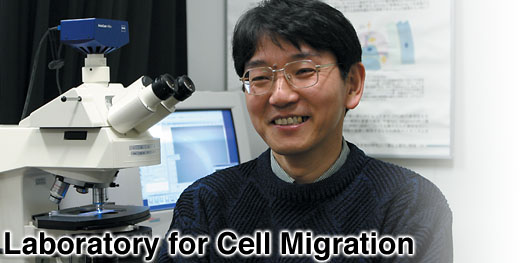





      |

In many forms of organogenesis, we can observe the coordinated movement of epithelial cells in sheets. For example, in the development of the lung, tubular epithelial sheets repeatedly extend and subdivide in branching patterns and thereby give rise to the minutely ramified and intricate structure of the airway. Epithelium is characterized by the presence of a basement membrane, an extracellular substrate in the form of a protein matrix, which plays important roles in regulating the direction and distance of epithelial cell migration. The main component of the basement membrane is collagen, but it comprises hundreds of other proteins as well, and abnormalities in the function of these proteins can lead to a range of developmental anomalies and pathologies.
We study the function of basement membranes in migration of epithelial sheets using a model organism called C. elegans, which is a species of tiny roundworm about 1 mm in length. In this worm, the gonads develop following a stereotyped pattern in which cells at the leading end of the migrating gonad (known as distal tip cells, or DTCs) travel along a U-shaped route in the larval body, thereby giving rise to an organ of that shape. The proper migration of the developing gonad relies on surface interactions mediated by the basement membranes of the gonad and the body wall. We study various mutant worms in which the direction of gonadal cell migration is abnormal to search for clues to the genetic and molecular bases of DTC guidance. One of the genes we have been focusing on encodes a metalloprotease named MIG-17, which localizes in the gonadal cell basement membrane and plays an important part in the determination of the DTC's migratory route by breaking down or modifying other membrane proteins. We have also discovered that a member of the fibulin family of secreted proteins is localized to the basement membrane in response to MIG-17 activity and also plays a role in directing cell migration. It is our hope that research such as this will provide insights into basic biological mechanisms that may one day make it possible to treat a range of health conditions in which cell migration is aberrant.